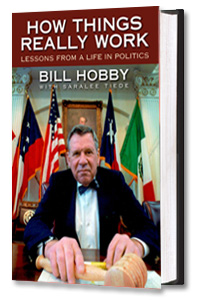Category Archives: Articles
A simple truth: 22-1 classroom ratio works
When a family hits a financial rough patch, they are forced to prioritize by separating the wants from the must-haves. State government is no different. This session, the Texas Legislature will wrestle with how to close a record-breaking $27 billion … Continue reading
CENSUS, APPORTIONMENT, REDISTRICTING
In just a few weeks, on April 1, we will all be counted by the twenty-third U. S. census. Then the fun starts. Congress will reapportion. Texas will gain three or four seats in Congress and electoral votes in the … Continue reading
TEXAS HAS BECOME A NATIONAL LAUGHINGSTOCK
Texas, once the Lone Star State, first became the Let’s Secede State (Rick Perry), and is now the Laughing Stock State (State Board of Education), Once a two-party state, Texas has become a tea-party state. What does it tell you … Continue reading
Robocalls—A Public Nuisance
Enough, already! During the last political season we have all been harassed in our homes by countless robocalls from rude people who want us to vote for them because they invaded our privacy. Let’s put a stop to it! We … Continue reading
Open Government – with no strings attached
In Texas the law is clear. Governing bodies must conduct the people’s business in public or else face some serious penalties. This statute has protected the public and elected representatives alike for the past 42 years with a basic premise: … Continue reading
Test 1: Before Saving the Nation’s Banks, Jones Bailed Out Houston
As the world struggles to come to grips with the global financial crisis, it might be instructive to look at how Jesse Jones and other Houston leaders dealt with an earlier banking calamity. The Chronicle’s Loren Steffy recently published an … Continue reading
SUSPICOUS AYE IN TEXAS HOUSE
Fraudulent voting in the Texas House of Representatives has been going on for a long time. It reached a new low last year when the House passed the “voter ID” bill to prevent fraudulent voting at the polls, of which … Continue reading
MEMORIES OF KARL ROVE
I had no Republican opponent when I first ran for Lieutenant Governor in 1972 and was re-elected in 1974 and 1978 without much opposition, but in 1982 the Repubs decided my free ride was over. My opponent was George Strake, … Continue reading
LADY BIRD JOHNSON
The Hobbys and the Johnsons have been friends for three generations now, bound together by broadcasting and government. Mrs. Johnson was the broadcaster in the family. Luci Baines Johnson grew up in both businesses, as did I. Sam Ealy Johnson, … Continue reading
POLL TAX
The poll tax was eliminated by the Twenty-fourth Amendment to the U.S. Constitution because it was used by former Confederate States to keep poor people, black and white, from voting. But the Texas Legislature never ratified the amendment. It almost, … Continue reading

